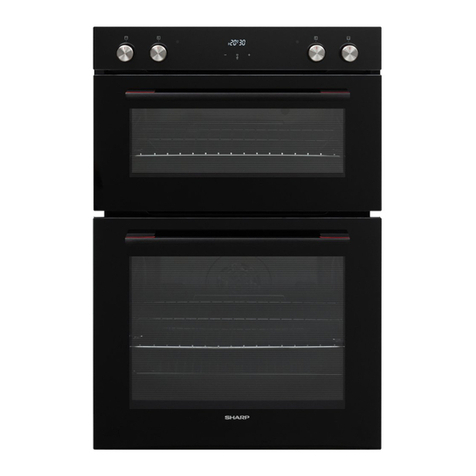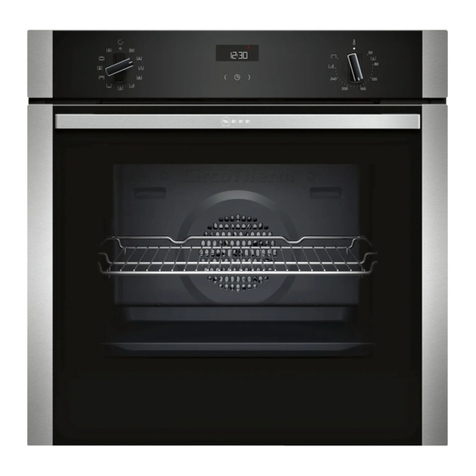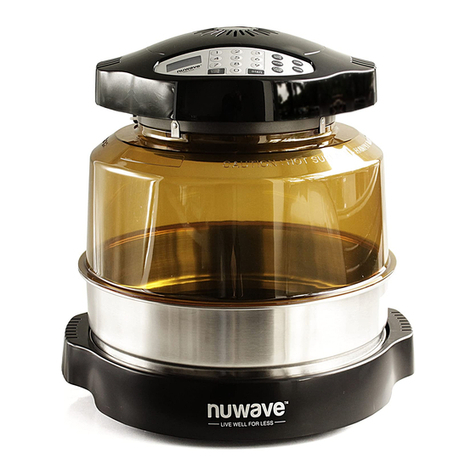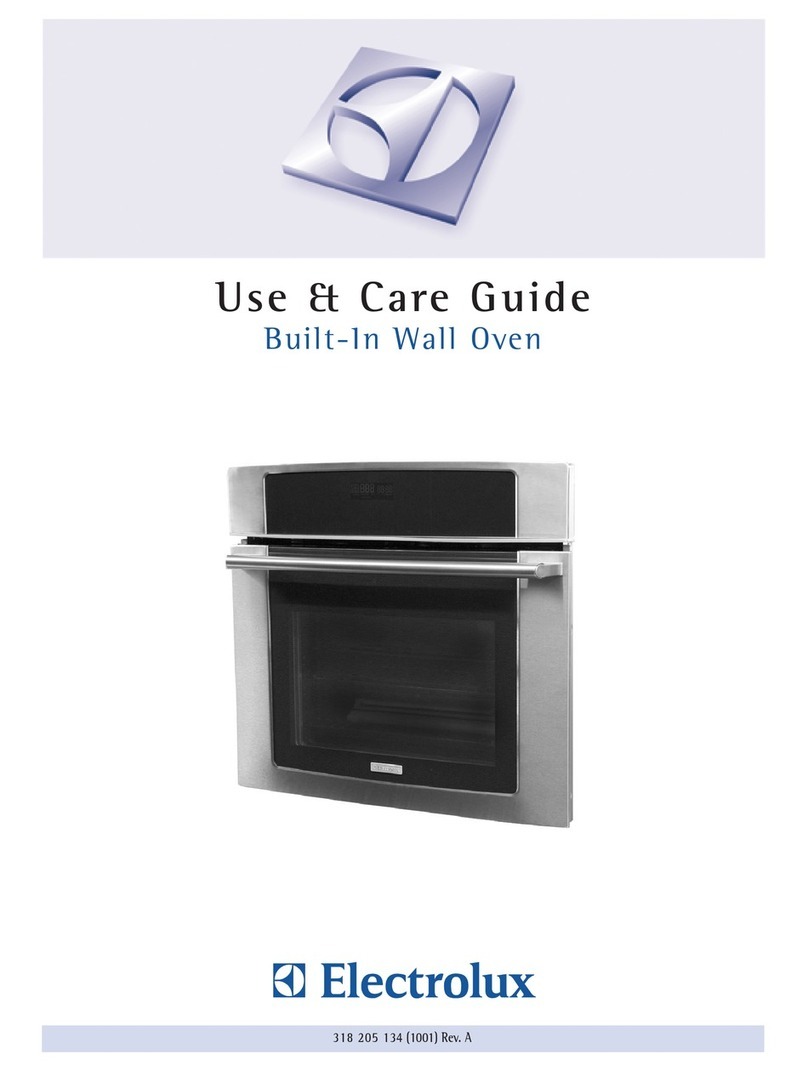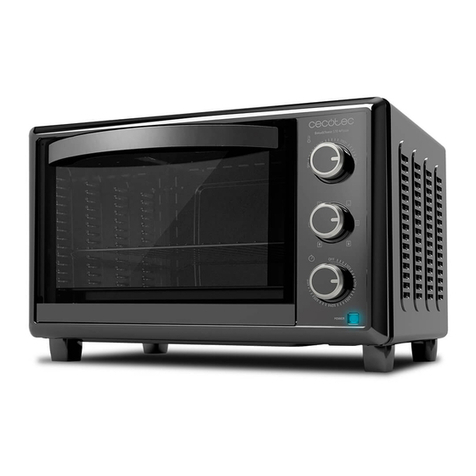Shel lab FX14-2 Quick start guide

CONSTANT
TEMPERATURE OVEN
MICROPROCESSOR
CONTROLLED
FLOOR MODELS:
FX14-2 & FX28-2
02/13
4861581-2
INSTALLATION AND OPERATIONAL MANUAL
Sheldon Manufacturing Inc. P.O. Box 627 Cornelius, Oregon 97113
EMAIL: tech@Shellab.com INTERNET: http://www.Shellab.com/~Shellab
1-800-322-4897 (503) 640-3000 FAX (503) 640-1366

2
TABLE OF CONTENTS
SECTION 1.0 RECEIVING AND INSPECTION
SECTION 2.0 GRAPHIC SYMBOLS
SECTION 3.0 INSTALLATION
SECTION 4.0 PRECAUTIONS
SECTION 5.0 CONTROL PANEL OVERVIEW
SECTION 6.0 OPERATION
SECTION 7.0 MAINTENANCE
SECTION 8.0 TROUBLESHOOTING
SECTION 9.0 PARTS LIST
UNIT SPECIFICATIONS
SCHEMATICS
This unit is a special purpose oven for professional, industrial or educational use
where the preparation or testing of materials is done at approximately atmospheric
pressure and no flammable volatile or combustible materials are being heated or
placed near or on top of unit. This unit is not intended for hazardous or household
locations or use.

3
RECEIVING AND INSPECTION
Your satisfaction and safety require a complete understanding of this unit. Read
the instructions thoroughly and be sure all operators are given adequate training
before attempting to put the unit in service. NOTE: This equipment must be used
only for its intended application; any alterations or modifications will void your
warranty.
1.1 Inspection: The carrier, when accepting shipment, also accepts responsibility
for safe delivery and is liable for loss or damage. On delivery, inspect for visible
exterior damage, note and describe on the freight bill any damage found, and
enter your claim on the form supplied by the carrier.
1.2 Inspect for concealed loss or damage on the unit itself, both interior and exterior.
If necessary, the carrier will arrange for official inspection to substantiate your
claim.
1.3 Return Shipment: Save the shipping crate until you are sure all is well. If for
any reason you must return the unit, first contact your customer service
representative for authorization. Supply nameplate data, including model
number and serial number.
1.4 Accessories: Verify that all of the equipment indicated on the packing slip is
included with the unit. Carefully check all packaging before discarding. The
FX14-2 is equipped with 3 shelves, 12 shelf clips and 4 leveling feet. The FX28-
2 is equipped with 6 shelves, 24 shelf clips and 4 leveling feet.
Section
1

4
GRAPHIC SYMBOLS
Your oven is provided with a display of graphic symbols which should help in
identifying the use and function of the available user adjustable components.
2.1 This symbol indicates that you should consult your
manual for further description or discussion of a
control or user item.
2.2 Indicates “AC Power”
2.3 Indicates “Manual Control”
2.4 Indicates “Timer”
2.5 C Indicates “Degrees Celsius”
2.6 Indicates “Temperature”
2.7 Indicates “Over Temperature Safety”
2.8 Indicates “Earth Ground”
2.9 Indicates “Potential Shock Hazard” behind partition
2.10 Indicates “Unit should be recycled” (Not disposed of
in land-fill)
Section
2

5
INSTALLATION
Local city, county or other ordinances may govern the use of this equipment. If you have any questions about
local requirements, please contact the appropriate local agency. Installation maybe performed bythe end user.
Under normal circumstances this unit is intended for use indoors, at room temperatures between 5and 40C,
at no greater than 80% Relative Humidity (at 25C) and with a supply voltage that does not vary by more than
10%. Customer service should be contacted for operating conditions outside of these limits.
Installation of the FX28-2 requires hard wiring and should be performed by a qualified electrical technician. The
next higher circuit breaker value above the data plate amperage may be used provided the requirements in
article 422 of the National Electric Code are met (USA). The FX14-2 can be installed by the end user without a
technician.
3.1 Power Source: The electrical supply circuit to the oven must conform to all national and local
electrical codes. Consult the incubator’s serial data plate for the voltage, cycle wattage and
ampere requirements before making connection. VOLTAGE SHOULD NOT VARY MORE THAN
10% FROM THE SERIAL PLATE RATING. This unit is intended for 50/60 Hz application. A
separate circuit is recommended to prevent possible loss of product due to overloading or failure
of other equipment on the same circuit.
3.2 Location: When selecting a site for the oven, consider all conditions which may affect
performance, such as extreme heat from steam radiators, stoves, ovens autoclaves, etc. Avoid
direct sun, fast-moving air currents, heating/cooling ducts, and high traffic areas. To ensure air
circulation around the unit allow a minimum of 30 cm between the unit and any walls or partitions
which might obstruct free airflow.
3.3 Lifting / Handling: These units are heavy and care should be taken to use appropriate lifting
devices that are sufficiently rated for these loads. Units should only be lifted from their bottom
surfaces. Doors, handles and knobs are not adequate for lifting or stabilization. The unit should
be completely restrained from tipping during lifting or transport. All moving parts, such as shelves
and trays should be removed and doors need to be positively locked in the closed position during
transfer to prevent shifting and damage.
3.4 Leveling: The unit must sit level and solidly. Leveling feet are supplied and must be installed in
the four holes in the bottom corners of the unit. With the unit standing upright, turn the leveling
feet counterclockwise to raise level. If the unit must be moved, turn the leveling feet in all the way
to prevent damage.
3.5 Cleaning: The oven interior was cleaned at the factory, but not sterilized. Remove all interior
parts if assembled and clean with a disinfectant that is appropriate to your application. DO NOT
USE chlorine-based bleaches or abrasives as this will damage the stainless steel interior. DO
NOT USE spray cleaners that might leak through openings and cracks and get on electrical parts or
that maycontain solvents that will harm the coatings. A similar periodic cleaning is recommended.
WARNING: Never clean the unit with alcohol or flammable cleaners with the unit connected to the
electrical supply. Always disconnect the unit form the electrical service when cleaning and assure all
volatile or flammable cleaners are evaporated and dry before reattaching the unit to the power
supply.
3.6 Burn In: It is recommended that the unit go through a “burning in” process prior to operation.
This is to eliminate the smoking of protective coatings on the element. Read sections 4, 5 and 6
carefully to understand operating requirements. To burn in turn the Overtemperature Safety to
maximum and set the digital display to 200. Run a minimum of one (1) hour until smoke
dissipates.
Section
3

6
PRECAUTIONS
4.1 The bottom surface of the chamber should not be used as a work
surface.
4.2 These units have been designed with dampered vents from the chamber. In
order to work effectively and safely, some precautions will need to be taken by
the operator.
A. In most applications, the EXHAUST damper will need to be opened
during drying or degassing for best results.
B. THIS OVEN IS NOT DESIGNED TO HANDLE COMBUSTIBLE
GASSES AND IS NOT AN EXPLOSION PROOF UNIT. Do not
place explosive, combustible, or flammable materials into the
chamber.
C. Some of the outgassed by-products may be hazardous or
unpleasant to operating personnel. If this is the case, the exhausts
should be positively ventilated to the outside and dealt with
according to local regulations.
4.3Do not operate near noxious fumes.
4.4 Do not place sealed or filled containers in the oven chamber.
4.5 Do not cut or remove the ground prong from the power cord.
4.6 Be sure that the power supply is of the same voltage as specified.
4.7Disconnect the unit from the electrical source before proceeding to make any
electrical repairs or replacements.
4.8 If a mercury thermometer is used and breakage should occur, all spilled mercury
MUST be completely removed from the chamber before continuing operation.
4.9 This oven is NOT designed for use in Class I, II, or III locations as defined by the
National Electrical Code.
4.10 This oven is not intended, nor can it be used, as a patient connected device.
Section
4

7
CONTROL PANEL OVERVIEW
5.1 Power Switch: The main power switch on the control panel (green lighted I/O) controls
all power to the unit and must be in the I/ON position before any systems are
operational. The switch will be lighted when in the I/ON position.
5.2 Timer Switch: The black I/O switch marked TIMER is located to the right of the power
switch. It controls the power to the time circuit. In the off position the oven heat is
controlled with no timed duration. In the on position the heat is controlled for a timed
interval and then the heat shuts off.
5.3 Main Temperature Control: This control is marked SET/TEMPERATURE and consists
of the digital display and UP/DOWN arrow pads for inputting set point temperatures and
calibration.
5.4 Overtemperature Safety Thermostat: This control is marked HIGH LIMIT and is
equipped with a graduated dial from 0-10. It is independent of the Main Controller and
guards against any failure which would allow the temperature to rise past the Main
Controllers set point. This allows continued operation of the oven until the problem can
be corrected or service can be arranged. It is not recommended that the unit be
operated for extended periods of time using only the Overtemperature Safety as the
controller as temperature uniformity will suffer.
5.5 OTP Light: This pilot lamp is marked OTP and is directly above the Overtemperature
Safety Thermostat. The light will come on when the Safety Thermostat has been
activated and taken control of the oven. Under normal operating conditions this pilot
lamp should never be on.
5.6 Timer Control: This control is marked SET/TIMER and consists of a digital display,
UP/DOWN arrow pads, a RESET “PUSH” pad, a START/STOP “PUSH” pad and a TIMER
ACTIVATED Light. This control provides the ability to set a timed heat interval, activate the
start-up of the timed heat cycle and shut down the timed heat cycle automatically.
5.7 Temperature Activated Light: This pilot lamp will be lit when the elements are receiving
power.
Section
5

8
OPERATION
6.1 Connection to Power Supply: Assure that the electrical power supply is properly configured
and rated for the oven. The FX28-2 must be hard wired as stated in Section 3.0, Installation.
6.2 Push the POWER switch to the ON position. The digital temperature display will indicate a
temperature value. Turn the Overtemperature Safety Thermostat to its maximum position,
clockwise, by using a flat-head screwdriver.
6.3 Set Main Temperature Controller: Enter desired set point temperature. To enter set point mode
on the controller, press either the Up or Down arrow pad one time. The digital display will start to
blink, going from bright to dim. While blinking, the digital display is showing the set point. To
change the set point, use the Up and Down arrow pads. If the arrow pads are not pressed for five
(5) seconds, the display will stop blinking and will read the temperature of the unit. Note that the
High Limit Thermostat should be turned to its maximum position until the unit has stabilized at
desired set point temperature. Allow the oven at least 24 hours to stabilize.
6.4 Calibration: Temperature calibration is done once the unit is installed in its working
environment and has been stabile at set point for several hours. Place a certified reference
thermometer in the chamber by either placing it directly inside, or through the access tube at the
top left of the unit. Be certain the thermometer is not touching any shelving. Allow the
temperature to stabilize again until the thermometer reads a constant value for one hour.
Compare the digital display with the reference thermometer. If there is an unacceptable
difference, put the display into calibration mode by pressing both the Up and Down arrow pads at
the same time until the display begins to flash. While the numbers are flashing the display can be
calibrated by pressing the Up or Down arrow pads until the display reads the correct value. Allow
the oven temperature to stabilize again, and recalibrate if necessary.
NOTE: Temperature accuracy should be checked at least monthly or after the unit has been turned off
for an extended period of time.
6.5 Set Overtemperature Safety Thermostat: As mentioned in step 6.3, the Safety Thermostat
should be initially set to its maximum position to allow the unit to stabilize. Once the oven is
stabile at the desired set point, turn the Safety Thermostat counterclockwise with a flat-head
screwdriver until the OTP light turns ON. Next, turn the Thermostat clockwise just until the OTP
light turns OFF. Then turn the thermostat clockwise two (2) of the smallest divisions on its scale
past the point where the light went out. This sets the Safety Thermostat at a temperature
approximately 10C above the Main Temperature set point. Note that the Safety is in series with
the output from the control relay, and the OTP light will be blinking when the Main Temperature
Controller is calling for heat.
6.6 Set Timer Display: Turn the Timer switch to the ON position. The SET/TIMER display digits will
light with no lighted decimals showing (See Figure 2). Note that if during any of the following
steps, several seconds elapse with no arrow pad or RESET pad activity, the timer will default to
the present displayed setting and it will be necessary to restart all functions over again. The
values must be programmed in a consecutive manner with no delays between settings or the
default will occur.
A. Hour Function: Press and hold the RESET pad until the digits start blinking and
a blinking decimal point is between digits 2 and 3. In this mode, pressing the UP
or DOWN arrow pads increases or decreases the whole hour value from 0 to 99
(digits 1 and 2).
Section
6

9
B. Ten Minute Function: After the correct value for hours is set, push the RESET
pad again. The blinking decimal will now move one digit to the right between
digits 3 and 4. Pushing the UP or DOWN arrow pads will increase or decrease
the ten minute function allowing values between 0 to 5 to be set (digit 3).
C. One Minute Function: After the correct ten minute value is set, push the
RESET pad again. The blinking decimal point will now move one digit to the right
beyond digit 4 and be located at the extreme bottom right of the display. With the
display in this mode, pushing the UP or DOWN arrow pad will increase the one
minute function allowing the value of digit 4 to be adjusted between 0 and 9.
D. Activation: Pause until timer stops blinking. After all settings are made, push
the START/STOP button. The timer activated light will come on and after a brief
pause, the present oven temperature settings will be valid and heating will begin.
The oven will now heat up, control at the set point and stop after the timed period
on the SET/TIMER display has elapsed.
Note that when the system is in the timer mode, the heating circuit is de-energized until
the START/STOP button is pushed or the TIMER switch is turned Off. If a time change
or correction is necessary and the timer has already been activated, push the
START/STOP button to “STOP” the timer, and then repeat steps A through D above.
6.7 To set the timer so that timed operation will not start until the oven is stabile at set point, pre-heat
the oven in the normal mode until the desired temperature has stabilized. Turn on the TIMER
switch. Push and hold the RESET button until the timer display blinks, this is to be sure that the
pre-set timed value is correct. Press the START/STOP button to activate the timer.
Figure Two

10
MAINTENANCE
7.1 Cleaning: Clean the oven interior and remove and clean shelves on a regular
basis. Use a disinfectant that is suitable for your application. DO NOT USE
chlorine-based bleaches or abrasives, as this will damage the stainless steel
interior. DO NOT USE spray cleaners that might leak through openings and cracks
and get on electrical parts or that may contain solvents that will harm the coatings.
A similar periodic cleaning is recommended. Use care when cleaning the door
gasket to prevent damage which could impair the positive door seal.
WARNING: Never clean the unit with alcohol or flammable cleaners with the unit
connected to the electrical supply. Always disconnect the unit form the electrical
service when cleaning and assure all volatile or flammable cleaners are evaporated
and dry before reattaching the unit to the power supply.
7.2 Storage: To prepare the unit for storage, remove all shelves and shelf clips, dry
the chamber completely and disconnect the power supply. Be certain that the
door is positively locked in the closed position. See Section 3.3, Lifting/Handling,
for proper transport procedures.
7.3 No maintenance is required on the electrical components. If the unit fails to
operate as specified, please see the Troubleshooting guide, Section 8.0, before
calling for service.
Section
7

11
TROUBLESHOOTING
TEMPERATURE
Temperature too high.
1/ Controller set too high-see section 6.3
2/ Controller failed on –call Customer Service.
3/ Wiring error –call Customer Service.
Display reads "HI" or "400"+.
Probe is unplugged, is broken or wire to sensor is broken –trace wire
from display to probe; move wire and watch display to see intermittent
problems
Chamber temp spikes over set point and
then settles to set point.
Recalibrate –see section 6.4.
Temperature too low
1/ High limit set too low –see section 6.5.
2/ Controller set too low –see section 6.3.
3/ Unit not recovered from door opening –wait for display to stop
changing.
4/ Unit not recovered from power failure or being turned off –ovens will
need several hours to warm up and stabilize.
5/ Element failure –compare current draw to data plate.
6/ Controller failure –call Customer Service.
7/ High limit failure –confirm with front panel lights that Safety
Thermostat is operating correctly.
8/ Wiring problem –check all functions and compare wiring to
schematic in section 9.0 - especially around any areas recently worked
on.
9/ Loose connection –check control panel for loose connections.
Display reads "LO"
1/ Bad probe or disconnected –call Customer Service.
2/ If ambient temperature is lower than range of unit –compare set
points and ambient temperature to rated specifications in section 9.0.
Unit will not heat over a temperature that
is below set point
1/ Confirm that fan is moving and that amperage and voltage match
data plate –check for air movement in chamber.
2/ Confirm that set point is set high enough –turn Safety Thermostat all
the way clockwise and see if OTP light comes on.
3/ Check connections to sensor.
4/ Check calibration –using independent thermometer, follow
instructions in section 6.4.
Unit will not heat up at all
1/ Check amperage –amperage should be virtually at maximum rated
(data plate) amperage.
2/ Do all controller functions work?
3/ Is the Safety Thermostat set high enough? –for diagnostics, should
be fully clockwise with the OTP light never on.
4/ Has the fuse/circuit breaker blown?
5/ Has timer turned unit off?
Indicated chamber temperature unstable
1/ ±0.1 may be normal.
2/ Is fan working? –verify movement of air in chamber.
Section
8

12
3/ Is ambient room temperature radically changing –either door
opening or room airflow from heaters or air conditioning ? –stabilize
ambient conditions.
4/ This may happen if exhaust stack is 100% open or if power exhaust
is cycling –adjust stack to at least ¼ closed.
5/ Sensor miss-located, damaged or wires may be damaged - check
mounts for control and OTP sensors, then trace wires or tubing between
sensors and controls.
6/ Calibration sensitivity –call Customer Service.
7/ High limit set too low –be sure that Safety Thermostat is set more
than 5 degrees over Main Controller set point; check if OTP pilot is on
continuously; turn controller knob completely clockwise to see if problem
solved then follow instructions in section 6.5 for correct setting.
8/ Electrical noise –remove nearby sources of RFI including motors,
arcing relays or radio transmitters
9/ Bad connection on temperature sensor or faulty sensor –check
connectors for continuity and mechanical soundness while watching
display for erratic behavior; check sensor and wiring for mechanical
damage.
10/ Bad connections or faulty solid state relay –check connectors for
mechanical soundness and look for corrosion around terminals or signs
of arcing or other visible deterioration.
11/ If set point is below 60 degrees, temperature can be unstable. See
unit specifications for individual ranges.
Will not maintain set point
1/ Assure that set point is at least 5 degrees over ambient.
2/ See if ambient is fluctuating; check for adjacent open doors or HVAC
duct openings –stabilize ambient conditions.
Display and reference thermometer don’t
match
1/ Calibration error –see section 6.4.
2/ Temperature sensor failure –call Customer Service.
3/ Controller failure –call Customer Service.
4/ Allow at least two hours to stabilize.
5/ Verify that reference thermometer is certified.
Can't adjust set points or calibration
1/ Turn entire unit off and on to reset.
2/ If repeatedly happens, call Customer Service.
Calibrated at one temperature, but not
at another
This can be a normal condition when operating temperature varies
widely. For maximum accuracy, calibration should be done at or as
close to the set point temperature.
MECHANICAL
Motor doesn't move
1/ If shaft spins freely: check connections to motor and check
voltage to motor.
2/ If shaft rubs or is frozen, relieve binding and retest.
Motor makes noise
1) Make sure that the fan or blower wheel is not contacting its
housing. Adjust the motor mounting bracket position to re-center
the fan or blower wheel, if necessary.
2) Check the fan or blower wheel for damage or out of balance
condition. Replace the fan or blower wheel if it is damaged or out
of balance.
3) Turn the motor shaft to make sure that it spins freely. If it binds
or the bearings make a rubbing or scrapping sound then replace
the motor.
Door not sealing
1/ Adjust hinge blocks or twist the door.

13
2/ Confirm that unit has not been damaged and body is not out of
square.
3/ Check physical condition of gasket for tears or punctures.
OTHER
Controller on at all times - "locked-up"
1/ Adjust set point to room temperature. If the unit is still heating,
replace the solid state relay.
2/Turn unit off and on to reset.
3/ If cannot change any condition on the front panel, call Customer
Service.
Controller timer resets on its own
1/ Confirm that power from wall is consistent and within specifications.
2/ Call Customer Service with serial number.
Front panel displays are all off
1/ Check connections to the temperature display control board and
assure that all are tight and in the correct orientation.
2/ Check for wire damage.
Unit or wall fuse/circuit breaker is blown
1/ Check wall power source.
2/ Compare current draw and compare to specs on data plate.
3/ See what other loads are on the wall circuit.
Unit will not turn on
1/ Check wall power source.
2/ Check fuse/circuit breaker on unit or in wall.
3/ See if unit is on, e.g., fan or heater, and just controller is off.
4/ Check all wiring connections, especially around the on/off switch.
Unit is smoking –Out of box
This is not an uncommon occurrence when first operating new units. Put
unit under vent and run at high temperature for one hour until smoke
dissipates.
Contamination in chamber
1/ See cleaning procedure in section 7.0.
2/ Develop and follow standard operating procedure for specific
application; include definition of cleaning technique and maintenance
schedule.
Contamination in sample
1/ See “Contamination in chamber”.
2/ Reduce air flow in chamber by dampening down exhaust port; be sure
to verify adequate temperature uniformity at the reduced air flow.
3/ Protect open samples from areas of maximum air current, e.g., inlet
air ducts.

14
PARTS LIST
Description
220V
Adjustable Feet
2700506
Black I/O Switch, Timer
7850579
Blower Motor
4880548
Cordset, FX14-2
1800539
Element FX14-2
9570737
Element FX28-2
9570730P
EMI Filter FX14-2
2800502
EMI Filter FX28-2
2800504
Fuse, 10amp 5 x 20mm
3300516
Green I/O Switch, Power
7850570
Knob, OTP
4450506
Pilot Light, Heating
4650554
Pilot Light, OTP
4650553
OTP Thermostat
1750648
Shelf Clip
1250512
Shelf FX14-2 & FX28-2
5130581
Temp/Time Control
1750613
Section
9

15
UNIT SPECIFICATIONS
These units are 240 volt. Please refer to the unit data plate for its individual
specifications.
Unit
Dimensions WxDxH
Weight
Capacity
Cubic Ft
Exterior
Interior
Shipping
Net
FX14-2
37X34X47
30.75x24.75x47
490 lbs.
280 lbs.
14
FX28-2
37.5x24.75x78.25
30.75x24.75x62.5
550 lbs.
390 lbs.
28
Temp. C
Range
Uniformity
Heat-up
Time to
150
Recovery to 150
Sensitivity
FX14-2
Amb. +5 to 260C
+ 1.5@ 100
14 min.
4 min (door open 30
sec.)
+ .05
FX28-2
Amb. +5 to 260C
+ 1.5@ 100
14 min.
4 min (door open 30
sec.)
+ .05

16
WIRE DIAGRAM
FX14-2
9851289
2800502
EMI
FILTER
2
34
1
OTP INDUCATOR
4650553
GREEN LIGHTED SWITCH 7850570
RED HT
RED HT
BLACK HT
BLACK HT
BLACK HT
1
24
FUSED INLET
4200505
RED HT
RED HT
FAN
37.0
999
TIMER
TEMP
HOT
NEUTRAL
GROUND
LOAD
RTD
1
2
4
RED WHITE
BLUE BLACK
BLACK HT
BLOWER MOTOR
4880548
TEMOERATURE
CONTROL WITH
TIMER
1750613
TIMER SWITCH
7850579
6600520
TOP HALF
OTP
1750648
BOTTOM HALF
OTP
1750648
HEATING
LIGHT
4650554
SOLID
STATE
RELAY
7030527 2000W
2350564
BLACK HT
BLACK HT
BLACK HT BLACK HT
BLACK HT
BLACK BLACK
RED HT
RED HT
RED HT
RED HT
RED HT

17
WIRE DIAGRAM
FX28-2
9851291
2800504
EMI
FILTER
2
34
1
OTP INDUCATOR
4650553
1
24
FAN
37.0
999
TIMER
TEMP
HOT
NEUTRAL
GROUND
LOAD
RTD
1
2
4
RED WHITE
BLUE BLACK BLOWER MOTOR
4880548
TEMOERATURE
CONTROL WITH
TIMER
1750613
TIMER
SWITCH
7850579
6600520
TOP HALF
OTP
1750648
BOTTOM HALF
OTP
1750648
HEATING
LIGHT
4650554
SOLID
STATE
RELAY
7030527
2000W
BLACK BLACK
RED HT
2000W
R1 COIL
½ R1 RELAY
7030525 ½ R1 RELAY
7030525
3
5
4
6
1 2
BLACK 10G
BLACK 10G
BLACK 10G BLACK 10G
BLACK 10G
BLACK 10G
BLACK 10G
BLACK 10G
BLACK 10G
BLACK HT
BLACK HT
BLACK HT
BLACK HT
BLACK HT
BLACK HT
RED HT
RED HT
RED HT
RED HT
RED HT

18
SHELDON MANUFACTURING, INC.
LIMITED WARRANTY
(Parts only, exclusive of labor)
Sheldon Manufacturing, Inc., (“Manufacturer”) warrants for the original user of this product that all parts, not including finished goods
products, it manufactures or resells will be free from defects in material and workmanship for a period of one year from the date of
delivery of this product to the original user (the “Warranty Period”). During the Warranty Period, Manufacturer, at its election and
expense, will repair or replace parts that are proven to Manufacturer’s satisfaction to be defective, or, at Manufacturer’s option, refund the
price or credit the price of any parts that are proven to Manufacturer’s satisfaction to be defective. This warranty does not cover any labor
or damage due to accident, misuse, negligence, or abnormal use. Use of parts in a system that includes components not manufactured by
Manufacturer is not covered by this warranty. Any alteration or removal of the serial number on Manufacturer’s parts will void this
warranty. Under no circumstances will Manufacturer be liable for indirect, incidental, consequential, or special damages. The
terms of this warranty are governed by the laws of the state of Oregon without regards to the principles of conflicts of laws thereof. If any
provision of this limited warranty is held to be unenforceable by any court of competent jurisdiction, the remainder of this limited warranty
will remain in full force and effect.
This warranty is in lieu of and excludes all other warranties or obligations, either express or implied. Manufacturer expressly
disclaims all implied warranties, including without limitation, the warranties of merchantability and fitness for a particular
purpose.
For fast and efficient support, please have the following information available anytime you request service:
Model __________
Serial No. __________
Part No. __________
This manual suits for next models
1
Table of contents
Other Shel lab Oven manuals
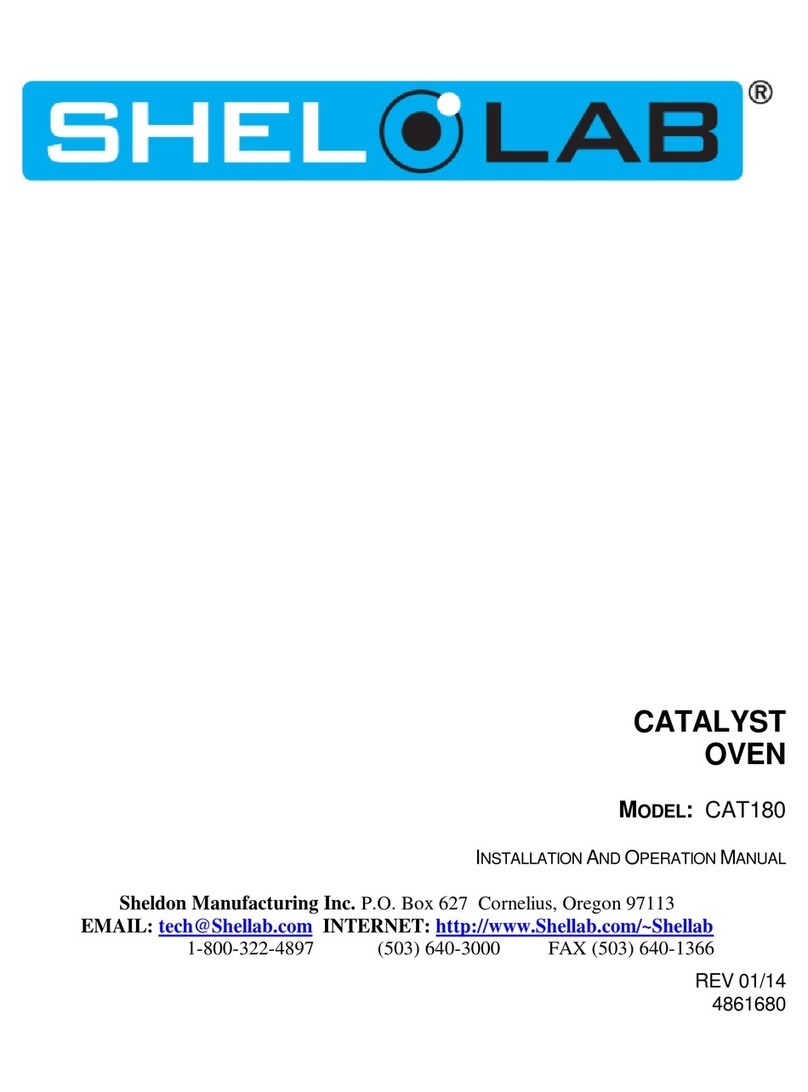
Shel lab
Shel lab CAT180 User manual

Shel lab
Shel lab SMO5CR-2 Quick start guide
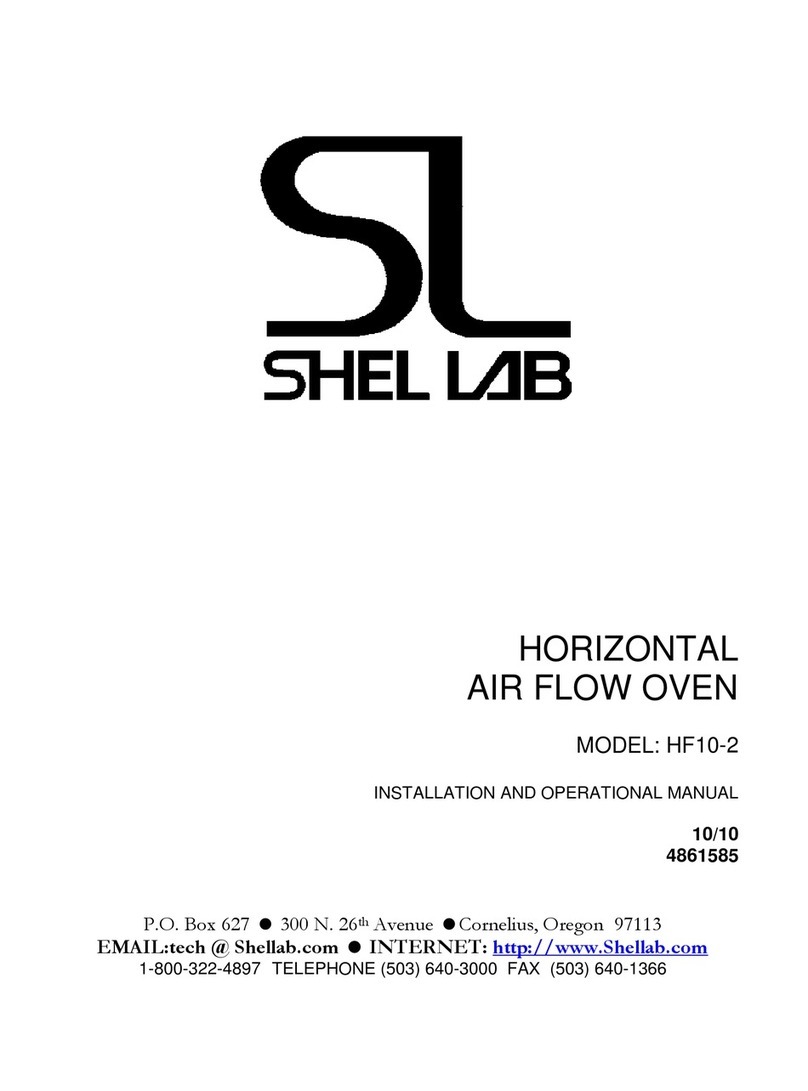
Shel lab
Shel lab HF10-2 Quick start guide

Shel lab
Shel lab HF2-2 Quick start guide
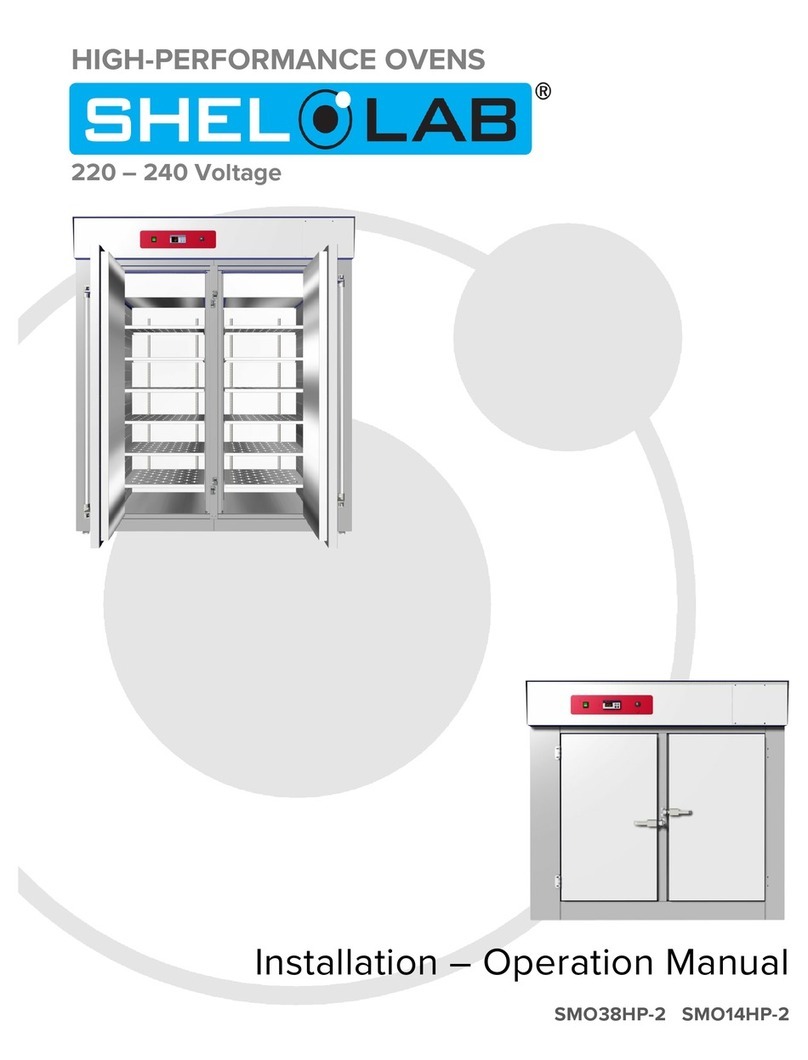
Shel lab
Shel lab SMO38HP-2 User manual
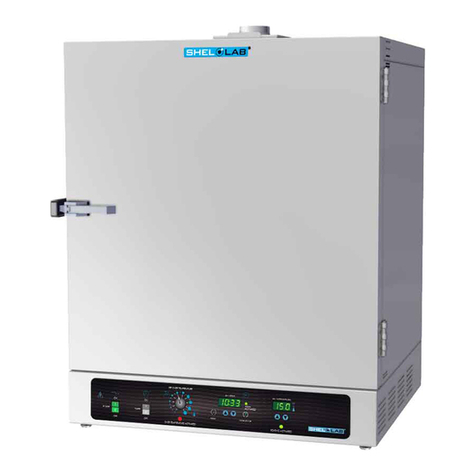
Shel lab
Shel lab SGO5-2 User manual

Shel lab
Shel lab SMO38HP-2 User manual

Shel lab
Shel lab SHELOLAB SVAC1 User manual
Popular Oven manuals by other brands

Samsung
Samsung BT63TDFST Installation and operating instructions
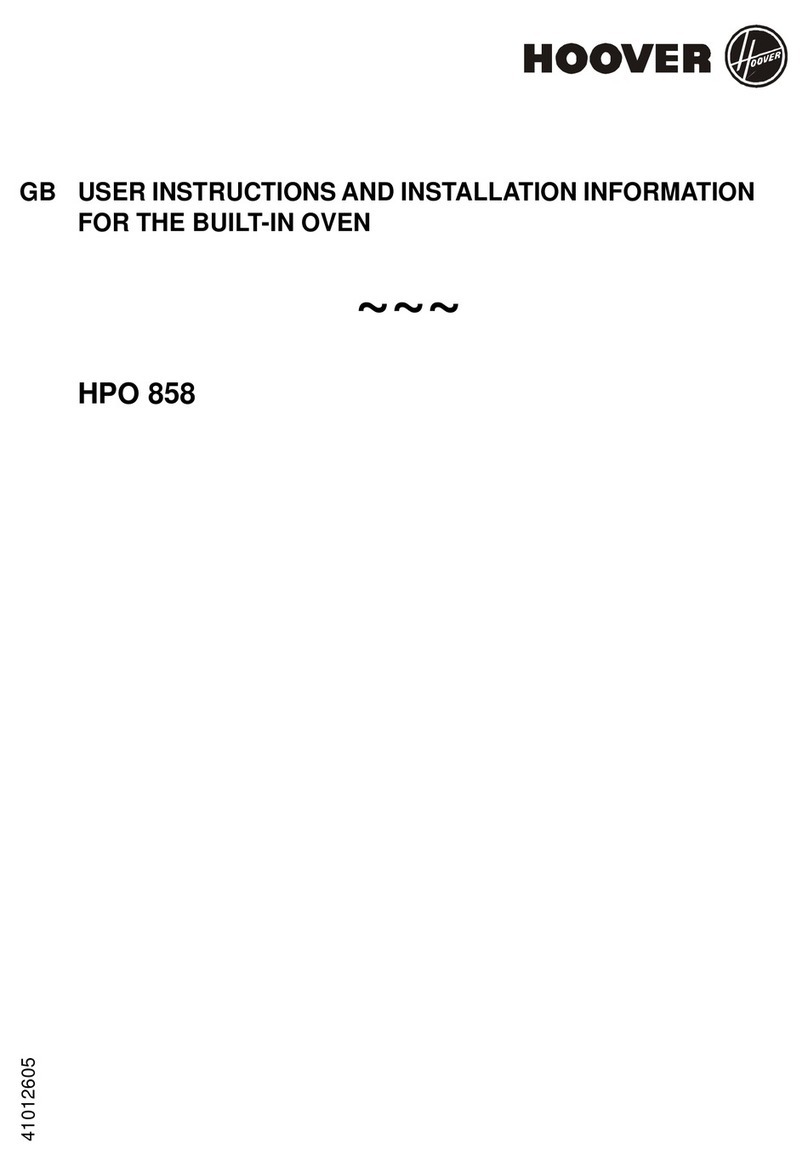
Hoover
Hoover HPO 858 User instructions and installation information
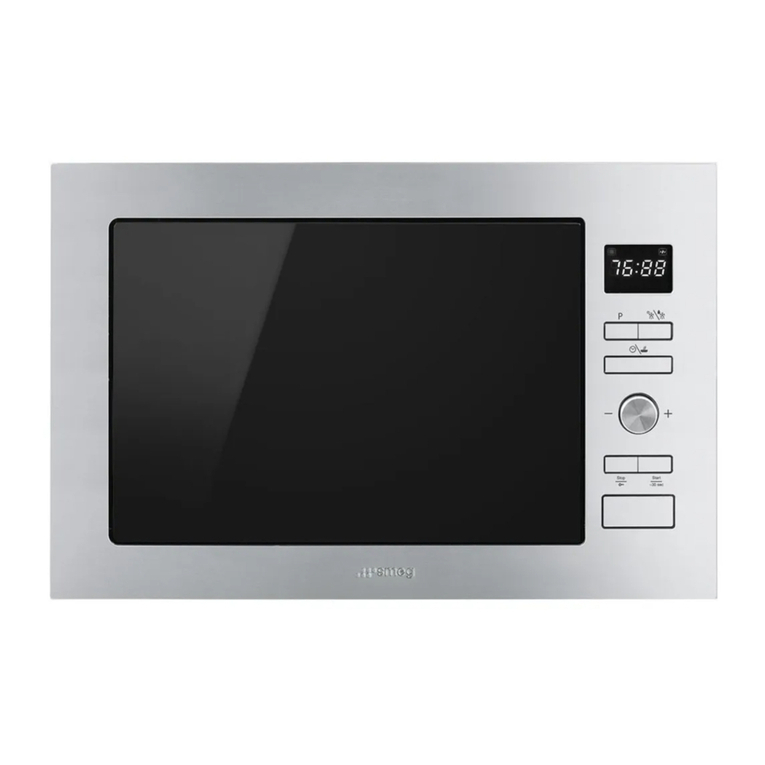
Smeg
Smeg FMI425X user manual
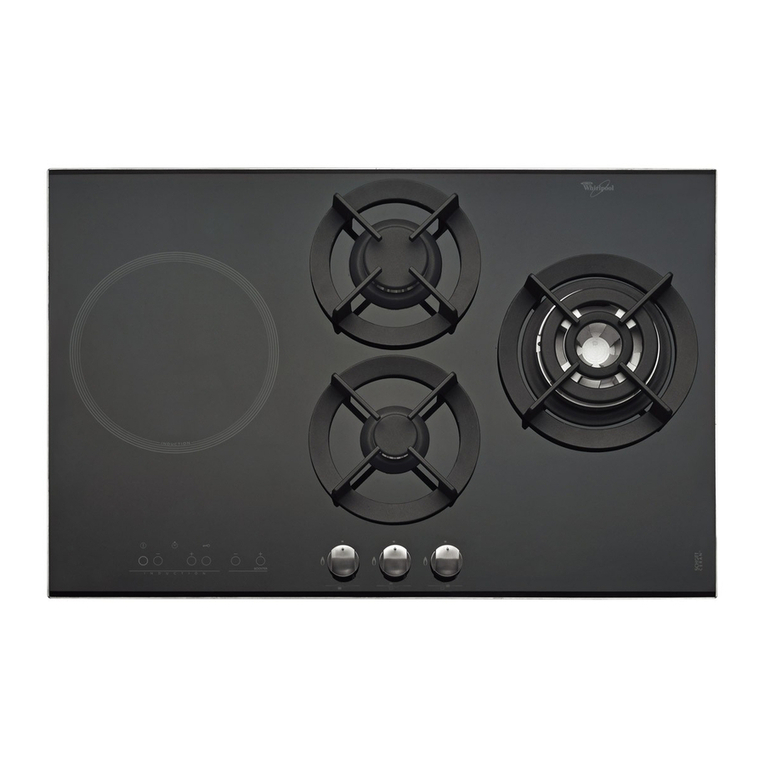
Whirlpool
Whirlpool AKT 477/IX Product description sheet
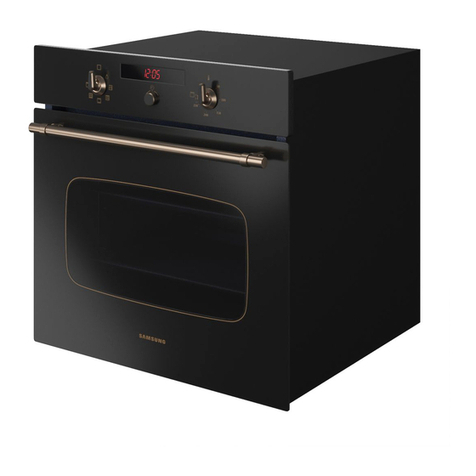
Samsung
Samsung NV70H3350CB user manual
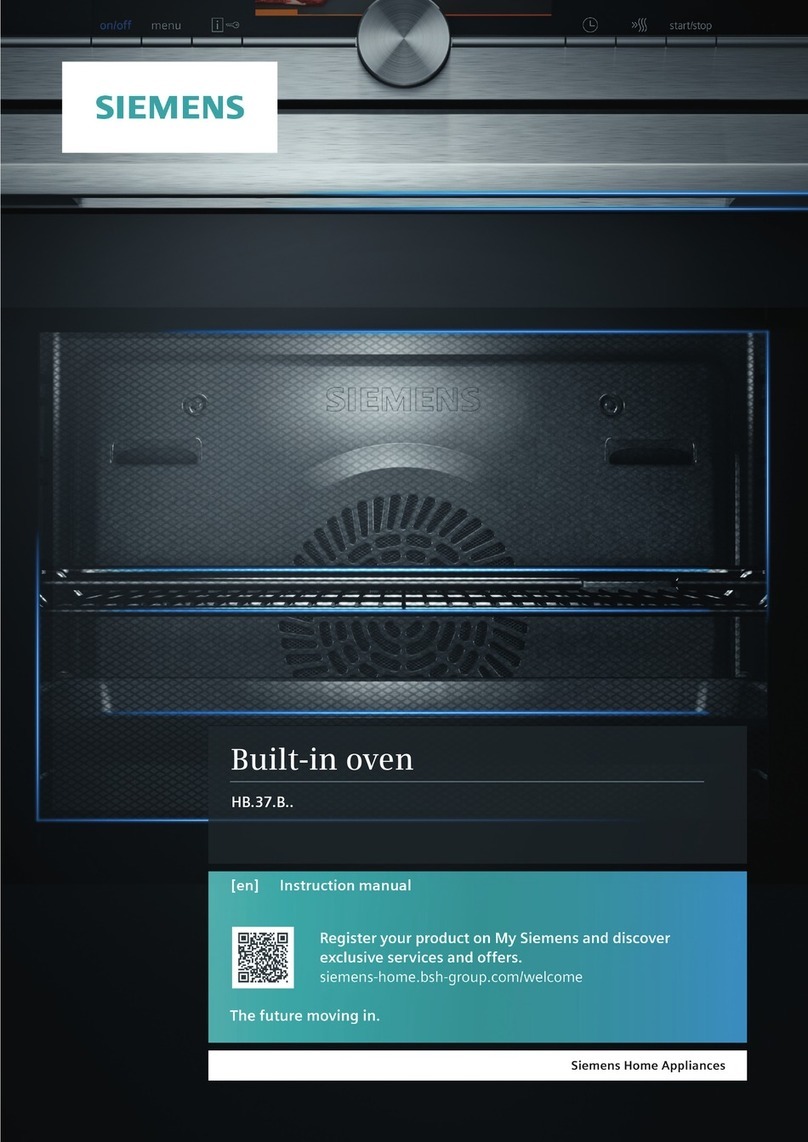
Siemens
Siemens HB 37 B Series instruction manual
